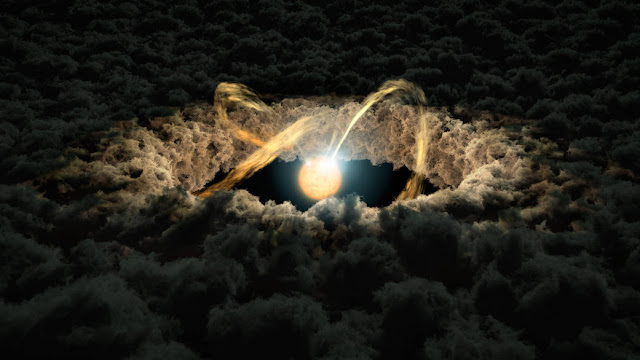 |
| Image: Star-forming region in the Carina Nebula. Credit: NASA, ESA, N. Smith (University of California, Berkeley), and The Hubble Heritage Team (STScI/AURA) |
In a recent paper (Mesa-Delgado et al. 2016)[1] the authors report the first direct imaging of protoplanetary disks in the star-forming region of Carina, the most distant, massive cluster in which disks have been imaged.
A protoplanetary disk is a rotating circumstellar disk of dense gas and dust surrounding a young newly formed star, a T Tauri star, or Herbig Ae/Be star. The protoplanetary disk may also be considered an accretion disk for the star itself, because gasses or other material may be falling from the inner edge of the disk onto the surface of the star. But this process should not be confused with the accretion process thought to build up the planets themselves.[2]
 |
| Image: This illustration shows a star surrounded by a protoplanetary disk. Material from the thick disk flows along the star’s magnetic field lines and is deposited onto the star’s surface. When material hits the star, it lights up brightly. Credits: NASA/JPL-Caltech |
Using the Atacama Large Millimeter/sub-millimeter Array (ALMA), disks are observed around two young stellar objects (YSOs) that are embedded inside evaporating gaseous globules and exhibit jet activity. The disks have an average size of 120 AU and total masses of 30 and 50 MJupiter. Given the measured masses, the minimum timescale required for planet formation (~1-2 Myr) and the average age of the Carina population (~1-4 Myr), it is plausible that young planets are present or their formation is currently ongoing in these disks.
 |
| Image: This picture of the ALMA antennas on the Chajnantor Plateau, 5000 m above sea level, was taken a few days before the start of ALMA Early Science. Nineteen antennas are on the plateau. Credits: ALMA (ESO/NAOJ/NRAO)/W. Garnier (ALMA) |
The non-detection of millimeter emission above the 4 sigma threshold (~7 MJupiter) in the core of the massive cluster Trumpler 14, an area containing previously identified proplyd candidates, suggest evidence for rapid photo-evaporative disk destruction in the cluster's harsh radiation field.
Protoplanetary disks can be dispersed by stellar wind and heating due to incident electromagnetic radiation. The radiation interacts with matter and thus accelerates it outwards. This effect is only noticeable when there is sufficient radiation strength, such as coming from nearby O and B type stars or when the central protostar commences nuclear fusion.
The disk is composed of gas and dust. The gas, consisting mostly of light elements such as hydrogen and helium, is mainly affected by the effect, causing the ratio between dust and gas to increase.
Radiation from the central star excites particles in the accretion disk. The irradiation of the disk gives rise to a stability length scale known as the gravitational radius (rg). Outside of the gravitational radius, particles can become sufficiently excited to escape the gravity of the disk, and evaporate.[3]
This mechanism would prevent the formation of giant gas planets in disks located in the cores of Carina's dense sub-clusters, whereas the majority of YSO disks in the wider Carina region remain unaffected by external photo-evaporation.
- Mesa-Delgado et. al 2016 (accepted in ApJL) - Protoplanetary disks in the hostile environment of Carina (arXiv)
- Protoplanetary disk (Wikipedia)
- Photoevaporation (Wikipedia)
Comments
Post a Comment